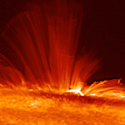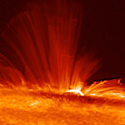Solar lab
Solar flares are caused by eruptions of the magnetic field near the sun’s surface that send out a blast of charged particles and intense electromagnetic radiation. The flares occasionally interfere with radio communication and electrical lines, but also play a role in the creation of the beautiful aurorae (the northern and southern lights).
Writing in Physical Review Letters, Shreekrishna Tripathi and Walter Gekelman, at the University of California, Los Angeles, US, describe their efforts to understand certain types of magnetic flux eruptions in the solar atmosphere by creating and imaging similar bursts in a laboratory-scale plasma chamber.
Tripathi and Gekelman focus on reproducing what are called “arched magnetic flux ropes,” literal arcs of magnetic flux on the sun’s surface that keep plasma confined for up to days at a time, before erupting. Within the confines of a - -long cylindrical chamber that contains an ambient plasma, they create an arched magnetic field (using two electromagnets) and generate a second plasma that is confined by this magnetic field. The arched magnetic field and the plasma it confines remain stable until two lasers ablate carbon targets near each of the arc’s feet, sending two jetlike blasts of positively charged carbon—roughly amperes—into the flux rope. The current produces its own magnetic field, creating a destabilizing kink in the flux rope that causes it to erupt with a wave of energy.
Tripathi and Gekelman’s images of the outward wave of plasma following the eruption provide a rare, albeit scaled down, glimpse of how such solar events evolve in time. – Jessica Thomas





